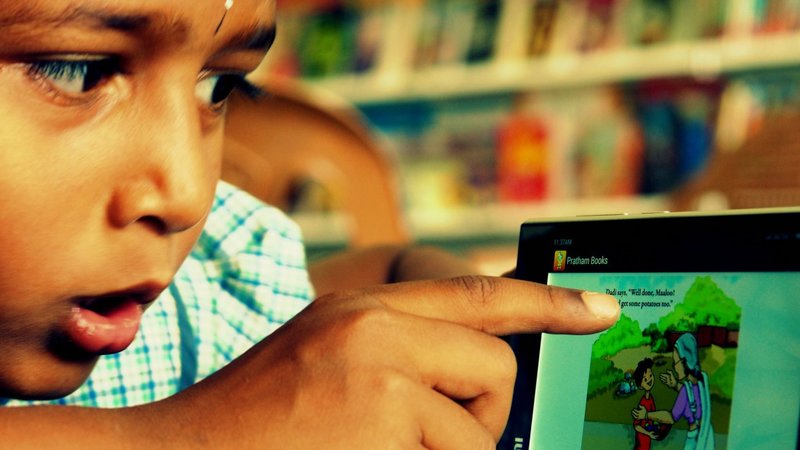Using Pratham Books and StoryWeaver in school libraries
Posted by Remya Padmadas on October 09, 2019Varsha Seshan is a children's writer, author of The Prophecy of Rasphora and The Story-Catcher, among others. She has twice been shortlisted for the Scholastic Asian Book Award, and a collection of her short stories, Dragonflies, Jigsaws and Seashells, was a finalist for the Best Middle-Grade/Young Adult Book at the Singapore Book Awards 2019. She conducts reading and writing workshops for children and adults at schools and libraries. She is also a classical dancer, with over 25 years of training in Bharatanatyam. Varsha has written two storybooks for Pratham Books - Today I Am and What Will Happen?
In this blog post, Varsha writes about a training workshop that she conducted with librarians of municipal schools around Mumbai, and using StoryWeaver to chalk out a library reading programme for these schools.
As a British Council trainer, I’ve conducted numerous reading workshops and facilitated many interactive sessions for theme-based reading challenges. I’ve worked in schools as well as at the British Library itself, interacting with a range of children, from those who devour books to those who yawn at the sight of a library.
So, when Anubhooti Learning Solutions (then ‘Experiential Learning Solutions’) asked me whether I would chalk out a reading programme to be administered by librarians at municipal schools in Mumbai and Navi Mumbai, I was interested. The project was a CSR initiative by D-Mart and the crux of the idea was to support a few schools through a library programme.
Excited, I drafted a detailed outline of what we could do. I devised a theme-based approach with detailed assessment criteria, for that was something that the reading programme team felt was crucial. I also worked out the learning outcomes, outline and structure of three training sessions for the librarians. All of them had worked in different capacities earlier and were to be associated with the library space for the first time. The purpose of my training sessions was to introduce them to their role beyond classroom management and discipline, emphasising that inculcating the habit of reading and a love for language is as much a part of a librarian’s role as the issue and return of books.
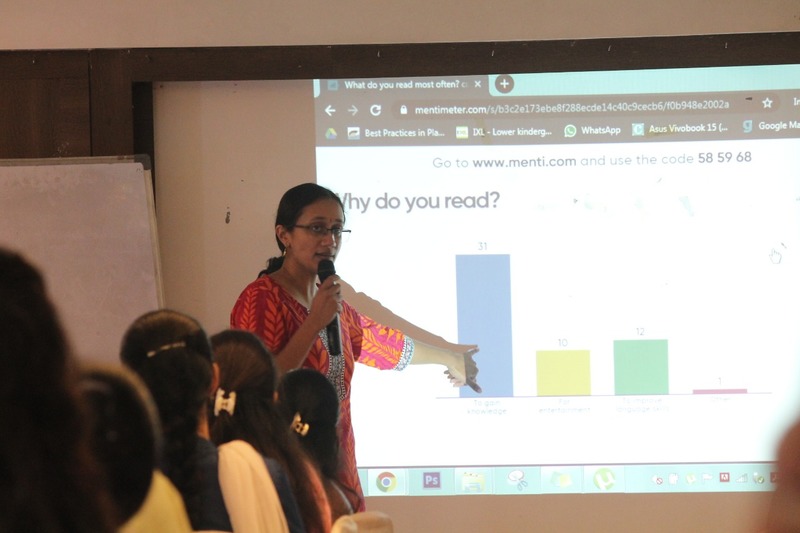
Varsha Seshan conducts a workshop for librarians from municipal schools around Mumbai
Yet, it was only as we launched the programme and began the first workshop that I began to understand how many problems the librarians face. A theme-based programme with assessment criteria was all very well. How would we deal with the other big issues, including the fact that many children did not even attend school regularly? As we went on, there were three problems that I was determined to address through the reading programme:
-
One, children come from multiple linguistic backgrounds. For instance, in a predominantly Hindi-speaking area, children attend a school where the medium of instruction is Marathi. “In my class of forty, only five children speak Marathi,” one librarian said to me.
-
Two, every class has students with varied reading levels. “The children who have been with us for some time are okay, on the whole, but new children come in all the time. If a child is ten years old, the school administration puts him in class five, even if he has not even learnt the alphabet yet!”
-
Three, some schools have different languages of instruction running concurrently. “My first period is with Hindi-medium children, then semi-English, then Marathi, then Hindi again. Each week, I have Urdu-medium, English-medium, Hindi-medium and Marathi-medium children coming to the library!”
What could we do? How could we hope to tackle such a wide range of problems?
Additionally, what started as a small group of eleven librarians soon began to grow. This is the third year of my association with Anubhooti and the D-Mart initiative, and we work with 47 librarians: D-Mart now supports 68 schools through its reading programme.
It is at this stage that my use of StoryWeaver in libraries comes in. D-Mart’s vision for the reading programme includes providing a minimum of 200 hard copies of Pratham Books in three focus languages (English, Hindi and Marathi) for each library that it supports. Five schools also use StoryWeaver books offline. This was a huge boon to me, for at least I had a starting point. I could access the same story in many languages, and thanks to the Creative Commons licence, I could encourage teachers to work with each story in multiple ways. Teaching requires so many resources that access to free material is invaluable!
Reading Levels
I was first attracted to StoryWeaver by the clear levelling of stories, and so, this was the first thing I introduced to the librarians too. In a single class, librarians deal with students struggling to read the alphabet as well as students who read stories confidently. With such a wide range of readers thrown together in one room, I find it particularly relevant that the reading level of books on StoryWeaver is not clearly linked to an age-group. This is important to me because slow learners are often targets for bullies. Reading a “kiddish” book, marketed as one for younger readers, leads to the shaming of slow learners, and a simple indication of reading level rather than age is an important step towards addressing (though not solving) this problem.
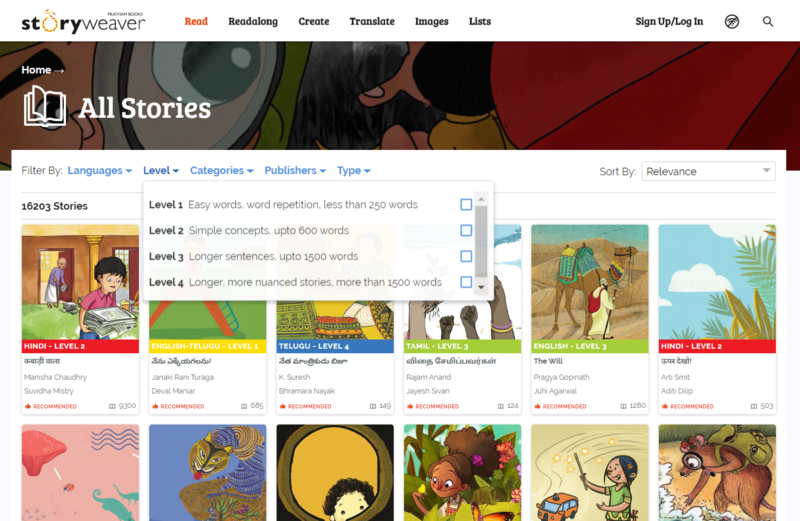
StoryWeaver has over 16,000 storybooks that are classified into four levels based on a child's reading level.
The first time we used StoryWeaver, we worked with three stories I love – I Am Not Afraid, Ammachi’s Amazing Machines and Farida Plans a Feast. We read each story many times, in three languages. Bilingual books are particularly wonderful in the context of this reading programme, for when a child is required to read in one language, even though s/he is more comfortable in another language, having both on the same page is a great aid to reading comprehension. All of us loved the simplicity and artwork of I Am Not Afraid. It allowed us to explore and enjoy the story without being daunted by complexity of narrative and vocabulary.
The main activity we engaged in after reading the books was to create simple stories of our own. Inspired by the sweet simplicity of I Am Not Afraid, librarians created wonderful picture books about conquering fear. This was just the first step because they took the idea back to their libraries and asked children to make books of their own. This was a huge boost to the reading programme, as it encouraged children to read more and write more. The most wonderful outcome was that even if they read nothing else, children wanted to read what their friends had created. An added bonus was that there were suddenly many more books in the school library!
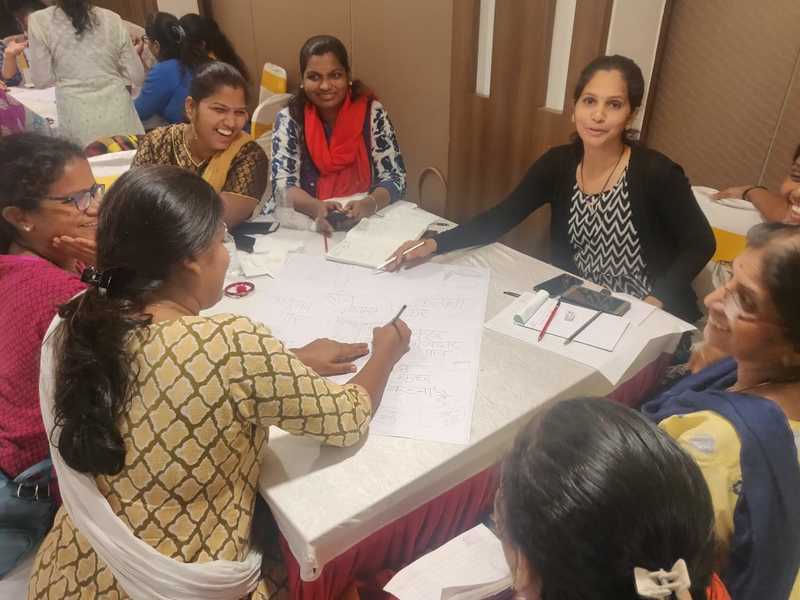
Librarians work on activities as part of the workshop
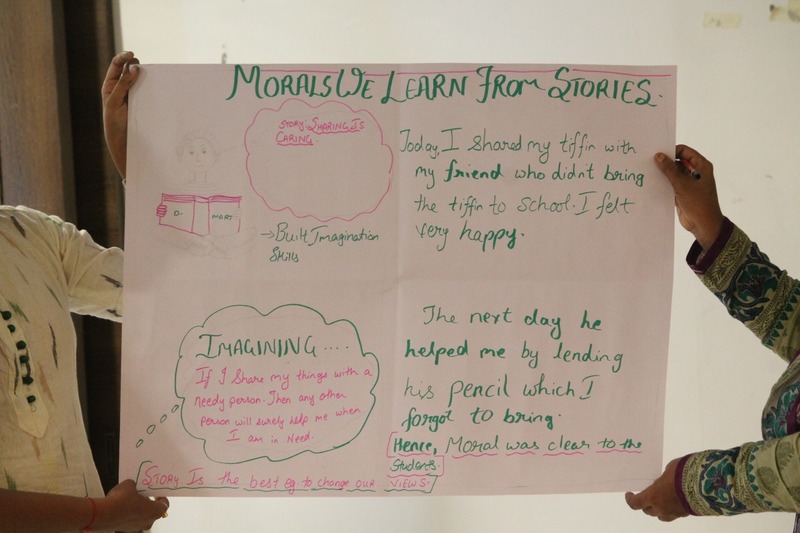
Librarians at the workshop prepare a chart on morals learnt from stories.
Wordless Picture Books
Wordless picture books are all kinds of lovely. We “read” the charming I Can Dress Myself! and then looked at how to work on language skills using a book that is written in none of the focus languages. Beginning with simple questions and answers – giving the girl a name and naming all the pieces of furniture in the room – we went on to a storytelling session, where the pictures in the book became visual aids.
Next, to continue our exploration of the use of StoryWeaver without language, I showed the participants Deepa Balsavar’s vibrant picture of a busy market. With so much happening in a single image, the librarians could explore a range of vocabulary. Consequently, they came up with various ideas of how they could use pictures in class to increase attention and concentration. We discovered that wordless picture books and the visual treat of any detailed image would include both children with very low language proficiency and confident readers who want something new.
Lists
The lists on StoryWeaver allowed me to modify the reading programme in the third year, making the entire programme much more accessible. In the first year, the feedback I received from the librarians indicated that a huge majority of older students did not want to read fiction. Working with non-fiction and stories that clearly reflect the world we see around us thus became important to the reading programme as we moved forward.
And so, for the third year, I chose to begin with three themes – Environment, Science and Technology, and Mathematics.
For the first theme, we read What’s Neema Eating Today? in English, and A Cloud of Trash and Anand in Marathi. Once we had read all three stories, it was time for our next activity.
In groups, the librarians chose a story to work with and present in a novel way. Some took the story further, imagining what would happen next. Others analysed the story in different ways, changing the setting to their own schools. Soon, through skits and quizzes, we had Chhakuli (the lead character in the Marathi translation of A Cloud of Trash) sorting out the garbage problem in a neighbouring village. We had Anand talking to his friends about taking pride in his work, and about there being no shame in working as a rag-picker. We had questions and answers about character motivation and themes. We discussed segregation of garbage and the role each of us must play in the process.
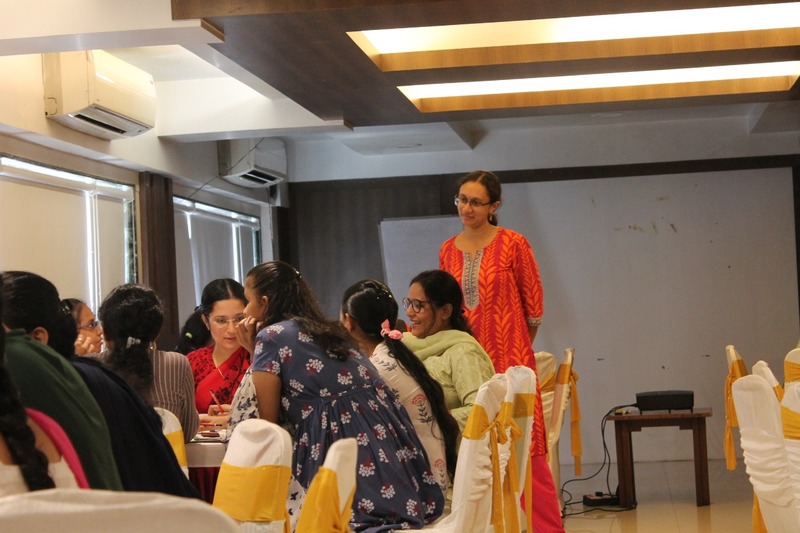
Varsha Seshan watches the prep for a play based on the book 'A Cloud of Trash'
For Mathematics, we read It’s a Laddoo Party! enjoying the repetition and humour in the tale. Working with maths stories was an intriguing idea for many, one that they could not wait to take to their classrooms.
As a quick recall activity for vocabulary, we also played a ballgame. When a ball is thrown to a participant, s/he must quickly say a word that is clearly related to one of the four stories we read. So we remembered what Neema ate, recalled characters like Peter Uncle and Mihir, and discussed seasons of the year.
What happens next?
While I work with only the librarians, the proof of the pudding is, of course, in the eating. As the librarians do not have easy access to audio-visual equipment, working with StoryWeaver remains, for the moment, limited to schools that have computer labs with books downloaded on the systems. Children read independently – either using StoryWeaver offline or hard copies of books in the library. Eventually, I hope that infrastructural changes will allow librarians to use StoryWeaver to the fullest, including the Readalong feature and YouTube channel.
Yet, exposure to all this material has ensured multiple gains. For one, the librarians themselves have begun to read. Their purpose is clear: using stories actively in the library so as to move beyond the rather monotonous role of distributing and collecting books. Secondly, a theme-based approach allows them to look at books in their collections in a new light and create new books that then encourage reluctant readers. Thirdly, access to the same book in all three languages makes the act of reading less daunting, especially when it comes to reading in a language that is not one’s mother tongue or first language.
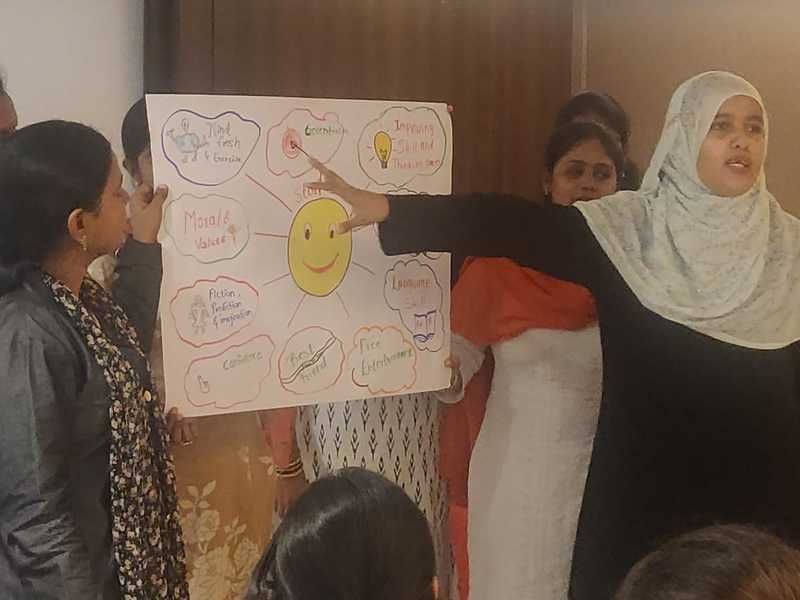
Librarians create charts based on stories discussed at the workshop.
And finally, feedback from the reading programme team at D-Mart is promising. Librarians and programme managers assure me that children now enjoy the books tremendously, and isn’t that the greatest victory of all?
Do join the conversation by leaving your thoughts in the comments section below! You can also reach out to us through our social media channels: Facebook, Twitter and Instagram.
Be the first to comment.The Story of Us: The Teachers & Educators 2018 Solver Class
Posted by Pallavi Krishnan on December 14, 2018written by Purvi Shah, Head - Digital Initiatives, Pratham Books
Earlier this year, MIT Solve asked the question 'How can teachers and educators provide accessible, personalized, and creative learning experiences for all?' More than 400 innovators from nearly 80 countries around the globe submitted solutions from which StoryWeaver was chosen to be one of the eight members to work on the challenge.
Take a look at the StoryWeaver pitch at the Finals and I'll tell you the story of the Teachers & Educators Solver Class of 2018.
The day after Solve Challenge Finals, eight individuals from all across the world sat huddled with coffees and a shot of inspiration on a cold New York morning, sharing the stories of the journeys that led us to that very room. We had just been selected as the new Teachers & Educators Solver class, and our orientation session was nothing short of invigorating, lighting a spark in each of us.
It was humbling to see that while we came from different countries and different backgrounds, our stories were similar, deeply rooted in our personal experiences. Yet we were all working towards a common goal: creating affordable, accessible, high-quality resources to educate our children.
My Story: How Stories Can Transform a Child
Personally, my mother has always stood up for me and for what is right. Growing up, this gave me the utmost confidence to be—and do—what I wanted. It also made me wonder what part I could play in making sure that every child lived her life with the same sense of security and confidence.
I’ve worked with Pratham Books, a unique nonprofit children’s book publishing house, whose mission is to put a book in every child’s hand, for 12 years now. I know that most underserved children are first generation readers and don’t have access to quality education.
Even more troubling is that their parents are often not equipped to help empower their children's learning. To support these children, we need to entrust this responsibility to their next circle of influence, their teachers, and give these teachers all the support they need.
This is why I am excited to lead the StoryWeaver platform for Pratham Books. StoryWeaver’s innovative publishing model addresses the inequality that exists globally—not enough children’s books, in not enough languages, with issues of poor access and affordability.
The platform provides open access to a large repository of storybooks, and has tools that allow the content to be translated and versioned to suit local needs. StoryWeaver has stories in tribal and endangered languages, and stories on overcoming domestic violence, civil rights, and STEM, which inspire children to learn effectively and dream big.
StoryWeaver puts the power in the hands of teachers to use, create, and adapt reading resources that help transform children.
Their Stories: Seven Inspiring Solutions
Carlos Pereira’s 11-year-old daughter, Clara, has cerebral palsy, making it impossible for her to walk or speak. Carlos spent a lot of time educating himself about his daughter’s disability. From there on, he built a series of services for people with disabilities. One of them is Livox, a software for Android tablets that uses machine learning and artificial intelligence that enables people with speech-related disabilities to communicate up to 20 times faster.
Having migrated from Korea to London, Heejae Lim understood the challenges faced by migrant parents. She founded TalkingPoints, an education technology nonprofit with a mission to make it easy for any parent to be actively engaged in their child’s education. The multilingual communication platform allows parents to communicate with teachers across language barriers.
Melissa Corto grew up with a special needs sibling and having worked extensively in the space, she knew that technology could aid special educators in effective teaching to improve results. She founded Education Modified to empower teachers with the latest research-based instructional strategies to effectively implement students’ Individualized Education Programs (IEP).
Passionate about seeing hands-on education manifest around the world, Heather Beem moved from her base in Boston to Ghana to start Practical Education Network, an organization that equips West African STEM teachers to employ inquiry-based pedagogies in their classrooms, using low-cost, locally-available materials.
Priya Lakhani founded Century Tech as a way to solve the crisis levels of student underachievement and teacher workload burden in the UK. Century is an educational platform that provides personalized learning for students, leveling the playing field by improving learning outcomes for all users. It empowers teachers with the right tools to deliver meaningful education.
Rudolph Ampofo went through the complete cycle of the Ghanaian education system, throughout which he always felt that he and his peers had limited access to education resources. Rudolph currently leads Eneza Education Ghana, an organization working towards improving access to quality and affordable educational resources by leveraging SMS, USSD, and web applications.
When she was 20 years old, Audrey Cheng moved to Kenya to work in venture capital. She quickly noticed that most tech experts in Kenya were self-taught, while many university IT grads could not find jobs. She realized that universities taught outdated skills that did not match the needs of companies, so she founded Moringa School to provide young Africans with in-demand digital skills to advance their careers.
The Story We Wish to Write
Each one of us Solver teams are inspired to do what we do because of our unique experiences. We left the Solver orientation session with not only a fresh view of our work, but also with new ideas, theories, plans, and designs to work towards our common goal: supporting the valuable resources that educate our children.
So, as the year progresses, we hope to partner to work towards achieving the UN Sustainable Development Goal which aims to “ensure inclusive and equitable quality education and promote lifelong learning opportunities for all.”
comment (1)
The wait is over! Here are the finalists for Retell, Remix and Rejoice 2019!
Posted by Shaoni Dasgupta on September 20, 2019 FINALLY! The results for Pratham Books’ Retell, Remix and Rejoice contest 2019 are here! A big thank you to all the participants for taking part, and being super patient with us as the judges read through each of your wonderful stories.
This year, we received 70 entries. It’s magical to witness the increase in the number and variety of language entries! English entries leading with 37 count definitely did not dim the light of the language entries which were 13, 6, 5, 4, 3 and 2 for languages Hindi, Urdu, Tamil, Kannada, Bengali and Marathi, respectively.
The lovely stories were graded with much patience and difficulty (they cut really close!) by the amazing team of editors at Pratham Books! They read and re-read the bunch and came up with the three top stories.
Many congratulations to… drum roll please!
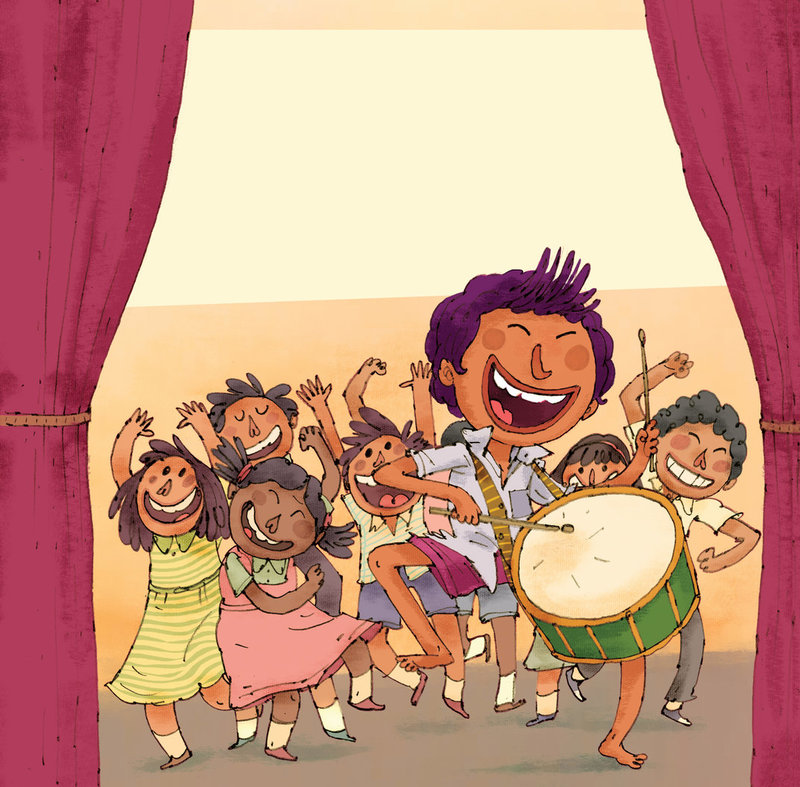
This illustration by Rajiv Eipe originally appeared in the print version of 'The Boy and the Drum' by Pratham Books.
- Aru for The Mehendi Boy (English)
- Bhakti Verma for Ek Kahani ki Kahani (Hindi)
- Aparna Chaubey for Agali Khiladi (Hindi)
Each finalist will receive a gift hamper of books from Pratham Books and will have a one-on-one feedback session with a Pratham Books editor. One final story will then be chosen for illustration.
You shall hear from us shortly.
comment (1)